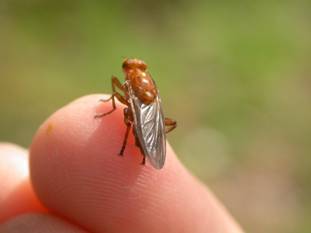A rare Highland insect is benefiting from a research project to determine the conditions it needs to thrive.
The aspen hoverfly, named for its preference for decaying aspen wood, has been the subject of a 14 year study by the Aspen Hoverfly Group to determine the cause of its decline and create the optimal conditions needed to restore the species to areas it once occupied.
Populations of this distinctive orange and bronze hoverfly, are now only found in Strathspey, in the RSPB’s Insh Marshes reserve.
Forestry operations and clearing of woodland for farmland are considered to be the main drivers of decline. The fragmented landscape that results has made it increasingly difficult for aspen hoverflies to find sufficient dead wood necessary to complete their life cycle.
Using a painstaking recording process that involved capturing individual flies, marking them with coloured paint, releasing them and monitoring their activity and movement, researchers from Stirling University, supported by RSPB Scotland and SNH, were able to determine the types of deadwood the aspen hoverfly prefer. They were also able to determine the optimal distance between aspen stands to assist the insects in dispersing.
More than 2000 hoverflies were colour marked and 190 of these were re-sighted. While most stuck close to the logs they came from, ranging an average of 0.6 miles away, some flew further afield, with one travelling as far as 3.1miles.
Researchers also found that the number of adult hoverflies emerging from the logs was far higher than anticipated, with previous estimates based on number of larvae found, raising hopes that the species will thrive under the right conditions.
The aspen hoverfly lays its eggs in the wet rotting cambium (layer of wood beneath the bark) of decaying aspen trees where the larvae feed on a rich soup of bacteria that slowly break the wood down. This food resource is limited however, as the dead wood only remains suitable for the hoverflies for a few years before drying out.
Jane Sears, Biodiversity Projects Officer at RSPB, said: “Thanks to this study we now know that 0.6miles is the optimum distance between aspen stands and we can target woodlands to help the expansion of the aspen hoverfly population. By monitoring the amount of dead and decaying aspen in these areas and maintaining a programme of aspen planting, led by the Highland Aspen Group, the hoverfly population should expand and help support healthy forests in these areas. By looking after the small creatures, big things can be achieved.”
